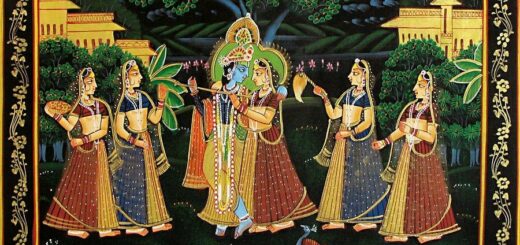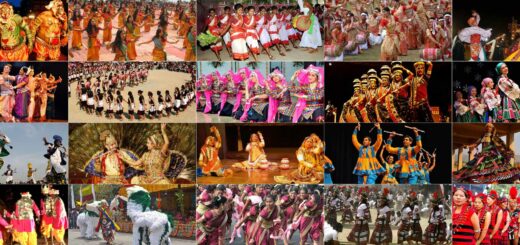History – Art & Culture – Gupta Sculpture
by
Mentors4ias
·
April 22, 2019
Introduction:
- The foundation of the Gupta empire in the 4th century A.D. marks the beginning of another era. The Gupta monarchs were powerful upto the 6th cenutry in North India. Art, science and literature flourished greatly during their time.
- The iconographic canons of Brahmanical, Jain and Buddhist divinities were perfected and standardised, which served as ideal models of artistic expression for later centuries, not only in India but also beyond its border.
- It was an age of all round perfection in domestic life, administration, literature, as seen in the works of Kalidasa, in art creations and in religion and philosophy, as exemplified in the wide-spread Bhagavata cult, which identified itself with an intensive cult of beauty.
- With the Gupta period India entered upon the classical phase of sculpture. By the efforts of the centuries, techniques of art were perfected, definite types were evolved, and ideals of beauty were formulated with precision.
- The Gupta sculptures not only remained models of Indian art for all time to come but they also served as ideals for the Indian colonies in the Far East.
- In the Gupta period all the trends and tendencies of the artistic pursuits of the proceeding phases reached their culmination in a unified plastic tradition of supreme importance in Indian History.
- Gupta sculpture thus is the logical outcome of the early classical sculpture of Amravati and Mathura. Its plasticity is derived from that of Mathura and its elegance from that of Amravati. Yet a Gupta sculpture seems to belong to a sphere that is entirely different. The Gupta artist seems to have been working for a higher ideal.
- A new orientation in the attitude towards art is noticed in the attempt to establish a closer harmony between art and thought, between the outer forms and the inner intellectual and spiritual conception of the people.
- The art of Bharhut, Amravati, Sanchi and Mathura came closer and closer; melting into one. In the composition, it is the female figure that now becomes the focus of attraction and nature recedes into the background, but in doing so it leaves behind its unending and undulating rhythm in the human form.
- The human figure, taken as the image, is the pivot of Gupta sculpture. A new canon of beauty is evolved leading to the emergence of a new aesthetic ideal. This ideal is based upon an explicit understanding of the human body in its inherent softness and suppleness.
- It is the sensitiveness of the plastic surface that the artist seeks to emphasise and for this; all superfluities, such as elaborate draperies, jewellery, etc., that tend to conceal the body, are reduced to the minimum. The wet or transparent clinging drapery hence became the fashion of this age.
- Under the patronage of the Guptas, the studies of Mathura and Sarnath produced several works of great merit. Though Hindu by faith, they were tolerant rulers.
The red sandstone image of the Buddha-Mathura

- The magnificent red sandstone image of the Buddha from Mathura is a most remarkable example of Gupta workmanship datable to the 5th century A.D.
- The great Master, in all his sublimity, is here shown standing with his right hand in abhayamudra, assuring protection, and the left holding the hem of the garment. The smiling countenance with down-cast eyes is robed in spiritual ecstasy.
- The robe covering both shoulders is skilfully represented with delicately covered schematic folds and clings to the body. The head is covered with schematic spiral curls with a central protuberance and the elaborate halo decorated with concentric bands of graceful ornamentation.
- The finished mastery in execution and the majestic serenity of expression of the image of Buddha came to be adopted and locally modified by Siam, Cambodia, Burma, Java, Central Asia, China and Japan, etc., when these countries adopted the Buddhist religion.
Standing Budha-Saranath
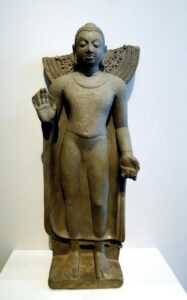
- The image of the standing Buddha is an excellent example of Gupta art in its maturity from Sarnath. The softly moulded figure has its right hand in the attitude of assuring protection.
- Unlike the delicately carved drapery folds of the Mathura Buddha, only the fringe of the diaphanous robe is here indicated. The perfect execution of the figure matched by its serene spiritual expression is truly worthy of the sublime being.
- Sarnath introduces not only a delicacy and refinement of form but also a relaxed attitude by bending the body in the case of the standing figure, slightly on its own axis, thus imparting to it a certain litheness and movement in contrast to the columnar rigidity of similar Mathura works.
- The folds have been discarded altogether; an indication of the drapery only survives in the thin lines on the body suggesting the edges of the garment.
- The folds that fall apart are given, again, a firmly muslin-like texture. The body in its smooth and shining plasticity constitutes the principal theme of the Sarnath artists.
Budha turning wheel of Law
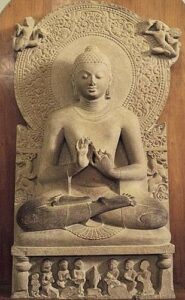
- The culmination of these characteristics seen in this sublime image of the Master represented in the act of turning the Wheel of Law is one of the masterly creations of Gupta classical sculpture.
- The image is carved in Chunar sandstone and has a surface texture of shining smoothness. The Master is shown as seated in Vijraparyanka with the hands held near the breast in Dharmachakrapravartana Mudra (the gesture of Preaching).
- A subtle discipline permeates the entire figure, physically as well as mentally. This is evident as much in the smooth and rhythmic treatment of the body as in the ethereal countenance suggestive of a mind absorbed and in serene enjoyment of spiritual bliss. A purely decorative background is supplied by the throne, lintel with makara ends, and a circular nimbus (Prabha) exquisitely carved with a broad foliated ornament within beaded borders. The decorative prabhas, it should be noted here, are characteristic also of Mathura images.
- During the Gupta period the characteristic elements of the Indian temple emerged and the plastic forms began to be used admirably as an integral part of the general architectural scheme. The stone carving from the temples at Deogarh and those from the temples of Udayagiri and Ajanta are excellent specimens of figure sculpture in their decorative setting.
Sheshashayi Vishnu from the Deogarh temple
- The large panel of Sheshashayi Vishnu from the Deogarh temple, representing the Supreme being slumbering wakefully on the serpent Ananta, the symbol of eternity, in the interval between the dissolution of the universe and its new creation, is a magnificent example.
- The four-armed Vishnu is reclining gracefully on the coils of the Adisesha, whose seven hoods form a canopy over his crowned head. His consort Lakshmi is massaging his right leg and two attendant figures stand behind her.
- Various gods and celestials are hovering above. In the lower panel, the two demons Madhu and Kaitabha, in an attacking attitude, are challenged by the four personified weapons of Vishnu. The whole composition fashioned with a masterly skill, breathes an atmosphere of serene calm and an agitated tension, making it a superb piece of art.
- A magnificent representation of Vishnu belongs to the Gupta period, 5th century A.D., and comes from Mathura. The typical gown, thevanamala; the charming string of pearls twirled round the neck, the long and elegant yagnopavita are all characteristic of early Gupta work.
Terracota Scupture-Ganga and Yamuna
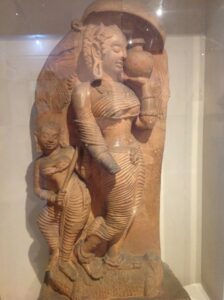
- Ganga and Yamuna, two life-sized terracotta images, originally installed in niches flanking the main steps leading to the upper terrace of the Shiva temple at Ahichhatra. belong to the Gupta period 4th century A.D. Ganga stands on her vehicle, the Makara (crocordile) and Yamuna on the cacchap (tortoise).
- Kalidas mentions the two river goddesses as attendants of Shiva and this occurs as a regular feature of temple architecture from the Gupta period onwards, the most notable example being the door jambs of the Brahmanical temple of Deogarh. Clay figurines (Terracottas) have great value as sources of social and religious history. In India, the art of making figurines of baked clay is of great antiquity as we have already seen at Harappa and Mohenjodaro where terracottas have been found in large numbers.
Terracota Sculpture-Shiva:
- The Head of Shiva is an elegant example of Gupta terracottas, depicted with matted locks, tied in a prominent and graceful top knot. The expression on the face is noteworthy and both the figures, of Shiva as well as Parvati, are two of the most charming specimens from Ahichhatra.
- The Head of Parvati with the third eye and crescent mark on the forehead. Her hair is beautifully arranged in spiral alaka-locks, with braid fastened by a garland and adorned by a floral boss. She is wearing a round earring with the Swastika mark on it.
- The Vakatakas were paramount in the Deccan, contemporary with the Guptas in the North. The high watermark of perfection in art achieved in their region can be best seen in the later caves at Ajanta, the early ones at Ellora and those at Aurangabad.










